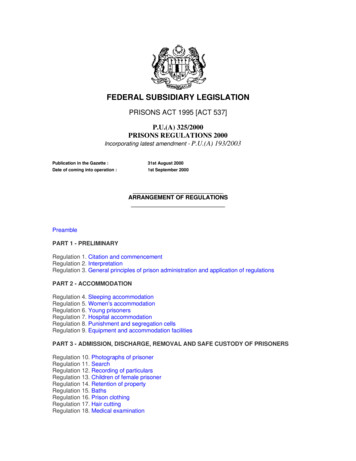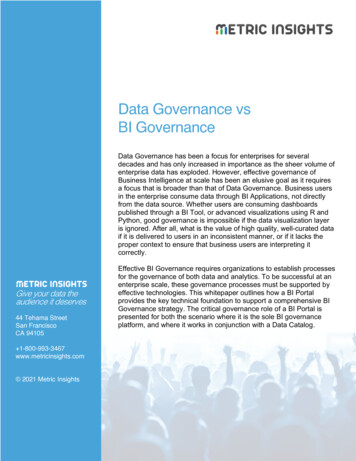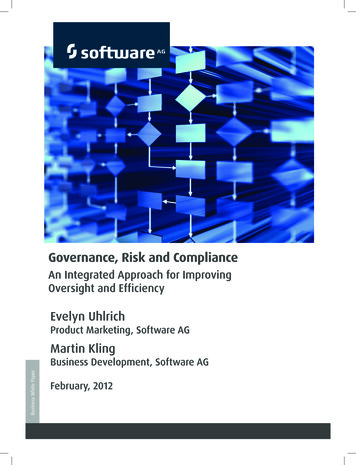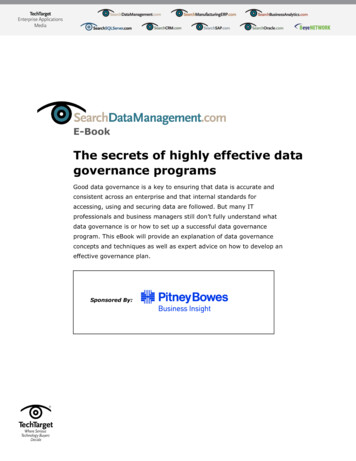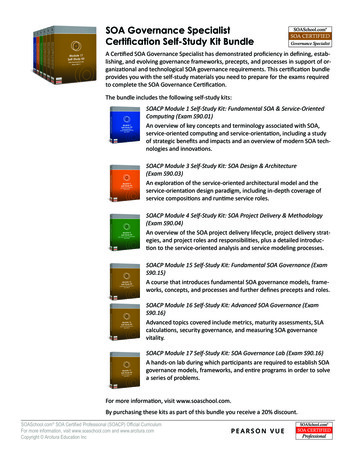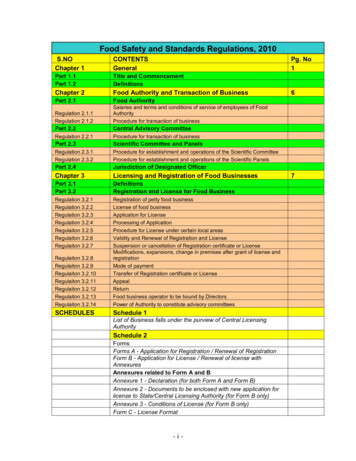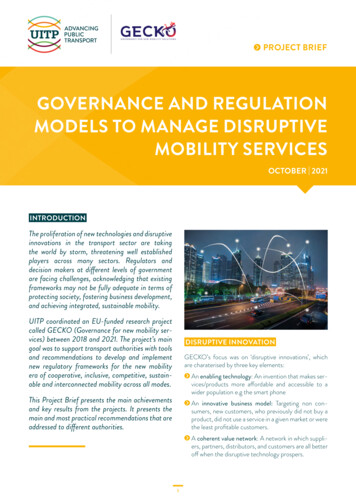
Transcription
PROJECT BRIEFGOVERNANCE AND REGULATIONMODELS TO MANAGE DISRUPTIVEMOBILITY SERVICESOCTOBER 2021INTRODUCTIONThe proliferation of new technologies and disruptiveinnovations in the transport sector are takingthe world by storm, threatening well establishedplayers across many sectors. Regulators anddecision makers at different levels of governmentare facing challenges, acknowledging that existingframeworks may not be fully adequate in terms ofprotecting society, fostering business development,and achieving integrated, sustainable mobility.UITP coordinated an EU-funded research projectcalled GECKO (Governance for new mobility services) between 2018 and 2021. The project’s maingoal was to support transport authorities with toolsand recommendations to develop and implementnew regulatory frameworks for the new mobilityera of cooperative, inclusive, competitive, sustainable and interconnected mobility across all modes.DISRUPTIVE INNOVATIONGECKO’s focus was on ‘disruptive innovations’, whichare charaterised by three key elements: An enabling technology: An invention that makes services/products more affordable and accessible to awider population e.g the smart phoneThis Project Brief presents the main achievementsand key results from the projects. It presents themain and most practical recommendations that areaddressed to different authorities. An innovative business model: Targeting non consumers, new customers, who previously did not buy aproduct, did not use a service in a given market or werethe least profitable customers. A coherent value network: A network in which suppliers, partners, distributors, and customers are all betteroff when the disruptive technology prospers.1
EXAMPLES STUDIED IN GECKOGECKO focused on four specific categories of innovativeand disruptive services and products, analysing theirmarket readiness, according to a market analysis1.CONNECTED, COOPERATIVE, ANDAUTOMATED MOBILITYAutomated vehicles: Defined as having “technologyavailable to assist the driver so that elements of thedriving task can be transferred to a computer system”3.In contrast, an autonomous vehicle where there is nohuman interaction.Connected vehicles: Defined as motor vehicles that“connects to other vehicles and/or devices, networksand services outside the car including the internet,other cars, home, office or infrastructure”2. In thefuture, connected vehicles may directly interact witheach other and with the road infrastructure, otherwiseknown as cooperative mobility.Table 1: Market Readiness ScaleNew mobility service/technologyConnected and automatedvehiclePassenger urban air mobilityMarket readiness (1-10)Market positioningMarket maturityNew market/Introduction /4-5(Between small-scale stakeholder Re-segmentation of existing market Development stagecampaign and large-scale early by employing a niche strategyadopter campaign)5-6(Between large scale earlyadopter campaign and proof oftraction1)Drone last mile deliveryNew marketIntroduction /Development stageNew market/Growth stageRe-segmentation of existing marketby employing a niche strategy6INFRASTRUCTURE, NETWORK, ANDTRAFFIC MANAGEMENTAn innovation in infrastructure can be defined asmanagement through pricing, taxation, digitalisation andintegration. Network and traffic management providesguidance to travellers on the condition of the roadnetwork, to ensure safe and efficient use of the network.Table 2: Summary of Market AnalysisNew mobility service/technologyBig data for fleet managementand logisticsTraffic management 2.0HyperloopMarket readiness (1-10)Market positioning6Proof of traction (Payingcustomers)New market (Introduction of bigdata in logistics not available before)Market maturityGrowth (Multiplication ofservice offers)Re-segmentation of existing market Introduction /4by employing a niche strategyDevelopment stageSmall scale stakeholder campaignNew market (Introduction of a newmode of transport)3Needs validationIntroduction/Development stage1 Market Readiness estimates the maturity of development of a product. A scale of market readiness helps identify whether a service or a product is in ideation.2 Gowling WLG, 2016. Are you data Driven?. UK Autodrive.3 European Parliament, January 2016, Automated Vehicles in the EU. Briefing.4 Proof of traction means that a product or service is mature enough that its position on the market has proved its power of traction of customers.2
MOBILITY AS A SERVICE AND PLATFORMSMobility as a Service (MaaS) is the integration of, andaccess to, different transport services in one single digitalmobility offer, with active mobility and an efficient publictransport system as its basis1. The MaaS platform is the ITstructure that is used by MaaS operators to provide thefinal service of mobility to the end-users.Table 3: Summary of Market AnalysisNew mobility service/technologyMarket readiness (1-10)Market positioningMarket maturityMaas5-6(Between large scale earlyadopter campaign and proof oftraction)New market/Re-segmentation ofDevelopment stageexisting market by employing a nichestrategyPassenger urban air mobility5-6(Between large-scale earlyadopter campaign and proof oftraction)New marketDevelopment stageSHARED ON-DEMAND MOBILITYprovided “on-demand”’, when requested by the customer, and not based on a fixed schedule.Shared mobility uses shared vehicles which are madeavailable to registered users at various locations in thecity. On-demand mobility, on the other hand, is serviceTable 4: Summary of Market AnalysisNew mobility service/technologyOn-demand ride sharingMarket readiness (1-10)Market positioning8(Proof of scalability)Market maturityNew marketGrowthBike sharing6-7(Between proof of traction andproof of satisfaction)Existing markettGrowth/MaturityE-scooter sharing / micromobility7–8(Between proof of satisfactionand proof of scalability)New marketGrowthRide-hailing8(Proof of scalability)New marketGrowthGrowth Hampus Lundgren - RuterCrowd shippingRe-segmentation of an existing8–9(Between Proof of scalability and market as a low-cost playerProof of stability)5 UITP, 2019. Ready for MaaS? Easier mobility for citizens and better data for cities. Report3
regulated. To ensure the successful implementationof innovations such as Intelligent Transport Systems(ITS) and MaaS, the data security, interoperability anddata ownership need to be addressed.REGULATION AND GOVERNANCEWhether these new services can contribute to atransformation of city’s mobility models in a more resilientand sustainable way, is the central to the research. Theresearch looked at specific regulatory and governingtools to support the definition and implementation of anappropriate framework for public authorities to ensurethese services contribute to the public good.The impacts of COVID-19 on innovative and disruptivemobility solutions and new governance practices hasresulted in a drop of patronage, a weaking of the businessmodels, but equally created opportunities from new userbehaviours. Similarly, governance from authorities as aresponse to the crisis has evolved, whether new policieshave been accelerated (such as more space for bicyclesand pedestrians) or new collaborative approachesimplemented with stakeholders of the new mobilityservice providers.3 The distributional impact: Ensuring equity and nondiscrimination is part of a national government role.When mobility innovations are introduced, inequitiesmight appear.4 inancing the development of disruptive innovations:FThe question of how to balance taxes, subsidies,use of infrastructure and public interest still standswhen more mobility innovations are introduced. Theproblem of taxation of smart mobility and the use ofpublic space needs to be addressed by governments.5 Changing role of citizens: With smart mobility, citizensprovide information to mobility actors and othercitizens; they provide services e.g in peer-to-peersharing. It is therefore important to raise awarenessabout the importance of data protection and ‘digitalempowerment’ of citizens.INNOVATIVE GOVERNANCE MODELSIn the context where existing regulations are insufficientor not adapted to these innovative and disruptive services,GECKO presents five innovative governance modelsand analyses their advantages and drawbacks. Suchmodels can be implemented to regulate fast evolvingtechnologies and business models, such as disruptivemobility innovations.EXISTING REGULATORY FRAMEWORKSThe project analysed the existing regulatory frameworksof mobility at the international, EU and local level. Theanalysis led to the conclusion that even if a developedand strong regulatory framework allows for a variety ofgovernance models to be implemented, some tailoredgovernance model should be considered to deal withdisruptive innovations.These generate critical governance issues that need to betaken into account:1 Timing: Regulators have a short window of opportunityto take over the governance from private actors, asthey adapt quickly.2T he regulation of data: Smart mobility innovationsprocess huge amounts of data on citizens. Besides thesignificant power conferred to these private entitiesissued from these data, this data collection presentsmajor risks for the travellers in terms of privacy if poorly4
Table 5 Governance models and regulatory approaches to disruptive mobility iveregulationExampleof policyinstrumentsDefinitionPolicies that canbe adjusted overtime, relying ondata collection andanalysisSelf/coregulationsDeployment ofthe innovationon restrictedand controlledconditions forimpact analysisSubsidies pacted by theregulations achievepolicy goals withoutconstraints on atoryactivities andresources activitiesallocated onevidence-basedassessment risksCollaborativeregulationAll stakeholdersinvolved in thedefinition of ensingExample formobilityStage ofdevelopmentThe SUMP(Sustainable UrbanMobility t zonesAdvantagesDrawbacksImpactassessmentHigh flexibilityHigher costfor impactassessmentPilot projectsInnovationfosteringCompliant withfast evolvingframeworkImpactassessmentReduced timeto-marketHigheracceptancyGDPR set up alist of objectivesto relevantstakeholders (e.g.Art. 17)ImpactassessmentAll policyinstrumentscan be usedCommissionImplementingRegulation (EU)2019/947 of24 May 2019on the rules andprocedures forthe operation ofunmanned aircraftPilot projectsCo-regulationMemorandum ofUnderstanding inLisbon to regulateshared mobilityDefinition ofstandardsVarious governance models can be suitable dependingon the context and on the stage of deployment ofHigh flexibilityHigheracceptancyImpactassessmentHigh costsRisks forconsumerstesting thesolutionLack ofguidanceHigher costfor impactassessmentBetter decisionmakingHigher costfor impactassessmentInclusiveapproach,sharing ofknowledge andresourcesTimeconsumingNo clearleadershipthe solution in the market. The choice of appropriategovernance model can be different, as illustrated below.Figure 1 Examples of suitable governance models for mobility innovations based on Regulation Readiness Level6Definition of normsand standardsExperimentation of atechnology/serviceRelated to a technology orservice already deployedCollaborative approachto ensure policy objectivesat the EU level andacceptancy by solutionprovidersBinding rulesto allow the deployment of mobility solutionRegulatory sandboxesto test the solution and provide impactassessmentMarket approachto select operators for this experimentationBinding rulesto define conditions of use(traffic codes, insurance, etc.)Collaborative approachfor local private-public cooperation (MOU)Market approachto limit number of operators,set up a cap on a fleet6 Regulation Readiness evaluates, on the one hand, whether existing regulations and laws are developed enough to help implement innovations and, on the other, whether regulationsand laws allow for mainstreaming of an innovative solution.5
CONCLUSIONCOMPLIANCE MAP: BEST PRACTICEIN REGULATIONAuthorities require support with tools for newregulatory frameworks to lead the transition tothe new mobility era of cooperative, inclusive,competitive, sustainable and interconnectedmobility across all modes.To design and development regulatory supportive tools for the regulations of disruptive mobilitysolutions, GECKO has produced a ComplianceMap1. This best tool illustrates the level of compliance of regulatory frameworks with respect toevolving current and future mobility markets andthe main barriers to market accessibility for different mobility services, business models and technologies.Many of the disruptive innovations presented inGECKO could bring much needed support toaccelerate the shift to sustainable urban mobility,contributing to a more integrated transport system.However, some may not. How can we ensure thatthese new products or services contribute to atransformation of our mobility and meet the publicgood and general interest? Of course, this is apolitical challenge and two warnings are put forward:This tool helps policy makers to provide prospectsat different levels of adherence with specific regulatory framework conditions and to anticipate policy actions and governance.RC - Countries ViewRC - Cities View lexible governance models (such as thoseFpromoted by GECKO) that are put in placeshould also be assessed: Any support thatauthorities could bring to innovative anddisruptive mobility solution providers by settinga specific framework should be evaluated e.gwhether flexible governance models should betemporary, whether a regime of exception shouldbe maintained are major issues.Regulation ComplianceRegulation Compliance4,32Evaluation CategoryMobility Solutions CountriesBig data for transport and mobilityCar-sharingConnected and Automated VehiclesDrone last mile deliveryMaaS and MaaS platformsOn-demand ridesharing and carpoolingRide-hailing and TNC2,6M onitoring the compliance of the developmentof new mobility services against public good andthe general interest, identifying the benefits anddrawbacks of disruptive and innovative transportsolutions should be fully part of authorities’ role.RRGECKO Compliance Index - Countries ViewLow Compliance1High Compliance 2021 Mapbox OpenStreetMap7 Available here: h2020-gecko.eu/tools/compliance-map6
RECOMMENDATIONSexchanges and create conditions for business modelsfor new mobility platforms to be developed.The following set of recommendations werespecifically aimed at European institutions andpublic authorities, however UITP believes thathave a global scope. They provide guidance todesign and implement more appropriate policies toenable adaptive and anticipatory governance and aregulatory framework for sustainable mobility.DATA STRATEGYThe EU should set up minimum requirements formobility service providers to manage data:Develop data management guidance for different topics (such as data privacy, protectionand ownership) to resolve legal ambiguities andgenerate certainty.NEW GOVERNANCEAND REGULATORY APPROACHESThe EU should support the establishment of clearstandards for the type and format of data to beshared sustainably:The European Union (EU) should establish acommon framework for governing mobilityinnovations: laborate standards based on consultation ofEboth transport and data experts and complywith international standard requirements. rovide a list of instruments that are appropriatePfor governance interventions in view of thespecifics of a mobility innovation. Guarantee a level-playing field and avoid marketasymmetry by forestalling data reciprocitybetween the private and public sectors. romote new flexible, adaptive governancePapproaches, such as collaborative governance,outcome-based regulation and regulatorysandboxes1 could be included in such framework. Ensure privacy obligations are not breached.Promote the value of data sharing, based among other elements on better understandingmobility trends and consumer preferences. ssess the appropriateness of each governanceAapproach that should be tailored to the featuresof the domain where they are applied. Ensure data ownership and sharing protocolsare equitable.COOPERATION OF SERVICES AMONGPUBLIC AND PRIVATE PARTIES Promote data analysis based on re-skilling andupskilling of professionals.The EU should identify and facilitate cross-sectoralcommunication across governance levels andindustry sectors and drive consultations aroundcommon needs between public and private parties.SUSTAINABILITY AND RESILIENCEOF MOBILITY Encourage the establishment of collaborationmechanisms or forums that include local andnational governments and are organised at aregular interval.The EU should define standardised proceduresand new forms of cooperation (with a flexibilitythat considers the specificities of the territory)for agreements between cities and new mobilityservice providers: uidance, best practice, and communicationGsupport should be provided by the EU. Thiswould also help the EU set policy direction.CREATING A REGULATORY ENVIRONMENTFIT FOR NEW MOBILITY SERVICES romote approaches and define a framework toPassess the impacts generated by the innovativeand disruptive mobility services against high levelsustainable strategies adopted by authorities.Public authorities, whether national or local, areencouraged to develop flexible regulations andpolicies which foster the development of new mobilityplatforms for knowledge and technological resource Grant visibility to cities and authorities thatadopt exemplary and effective decarbonisationstrategies involving innovative and disruptivemobility service providers.8 Further explained in paragraph 2.3. of the GECKO Report, Regulatory schemes and governance models for disruptive innovation.7
THANK YOU TO THE PROJECT PARTNERS Abo Akademi CORTE POLIS Universita’ Commerciale Luigi Bocconi Absiskey Fit Consulting Rupprecht Consult University College LondonThis is an official Project Brief of UITP, the International Association of Public Transport. UITP has more than 1,800 member companies in 100 countries throughout the world and represents the interests of key players in this sector. Its membership includes transport authorities, operators, both private and public, in all modesof collective passenger transport, and the industry. UITP addresses the economic, technical, organisation and management aspects of passenger transport, as wellas the development of policy for mobility and public transport worldwide.This Project Brief is part of the research project GECKO which has received funding by the European Union’sHorizon 2020, under grant agreement No 824273. Find out more at h2020-gecko.euDIGITAL VERSION AVAIL ABLE ONOCTOBER 2021Rue Sainte-Marie 6, B-1080 Brussels, Belgium Tel 32 (0)2 673 61 00 info@uitp.org www.uitp.org UITP - All rights reserved - Responsible Publisher: Mohamed Mezghani, Rue Sainte Marie 6, B-1080 Brussels, Belgium - Legal deposit: D/2021/0105/32
governance model should be considered to deal with disruptive innovations. These generate critical governance issues that need to be taken into account: 1 Timing : Regulators have a short window of opportunity to take over the governance from private actors, as they adapt quickly. 2 The regulation of data: Smart mobility innovations
